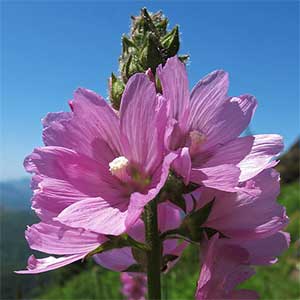Sidalcea hirtipes
Sidalcea malachroides
bluff mallow, bristly-stem checker-mallow, bristly-stem checkerbloom, hairy-stem checkermallow
maple-leaf checkerbloom, maple-leaf sidalcea
several, scattered, erect, arising from rhizome apices, usually slightly hollow, densely, harshly bristly-hirsute, hairs stiff, pustular, simple, forked, or stellate, often 2–2.5 mm.
clustered, erect, solid, bristly-hirsute, hairs simple, forked, and stellate.
basal and cauline;
stipules linear-subulate, 6–8 × 1–1.5 mm;
petioles of proximal leaves 20–30 cm, 3 times as long as blades, reduced distally to 1/2 times as long as blades;
blades: basal and proximalmost orbiculate to reniform, shallowly 5–9-lobed, 10–15 × 10–15 cm, thick, base narrowly cordate, lobe margins coarsely crenate-dentate, apex rounded, surfaces coarsely hirsute, hairs stiff;
distal orbiculate, deeply palmately 5–7-lobed, incised ± to base, lobes sometimes lobed again, base cuneate, apex acute, deeply 2–3-toothed, surfaces long-hirsute or with 2–4-rayed, stellate hairs abaxially.
cauline, evenly arrayed on stem, similar in size and shape;
stipules linear-lanceolate, 5–15 × 0.5 mm;
petioles 4–7 cm on distal leaves, 1/2 times to as long as blades, longer on proximal leaves;
blade maplelike, usually palmately (3–)5–7- 7–15 mm, pistillate 6–7 mm, bisexual or staminate 10–12 mm;
staminal column 5–7 mm, hairy;
anthers white to pale purplish or pale yellowish;
stigmas 5–9.
erect, spiciform to subcapitate, dense, calyces usually conspicuously overlapping in flower and sometimes in fruit, proximals usually long-pedunculate, unbranched or branched, 20+-flowered, 10+ flowers usually open on spike at same time, not interrupted, not 1-sided, usually to 8 cm, usually not elongate but sometimes slightly elongated in some populations and to 20 cm in fruit;
bracts paired or single, linear, distal undivided, proximal distinct to base, 6 mm, mostly slightly longer than pedicels.
1–3(–5) mm;
involucellar bractlets absent.
bisexual or unisexual and pistillate, plants gynodioecious;
calyx often purple tinted, 9–11 mm, to 11–16 mm in fruit, margins ciliate, hairs 1–2 mm, surfaces finely stellate-hairy at base and with coarser, longer, simple and stellate hairs apically;
petals usually pale pink to rose-lavender, rarely white, slightly or not pale-veined, (9–)10–21 mm, pistillate often 9–14 mm;
staminal column 5–7(–10) mm, hairy;
anthers white;
stigmas 5–10.
2.5–3.5 mm.
1–1.5 mm.
7–8 mm diam.;
mericarps 5–10, 3.5–4 mm, glabrous or sparsely stellate-puberulent, roughened, prominently reticulate-veined, sides rugose and pitted, back less so, mucro 0.6–0.8 mm.
5–6 mm diam.;
mericarps 5–9, 2.5 mm, glabrous or sparsely stellate-hairy, margins rounded, back ridged, sides smooth or with slight corrugations near margins, not pitted, mucro absent.
= 60.
= 20.
Sidalcea hirtipes
Sidalcea malachroides
Of conservation concern.
Sidalcea hirtipes is uncommon and known from Clatsop, Lincoln, and Tillamook counties in Oregon and Clark, Lewis, and Wahkiakum counties in Washington. Its elevation and habitat vary, and it seems as much at home on steep coastal cliffs as in more inland, historic prairies and mountain meadows. Populations can appear to be large because of the long-rhizomatous and clonal nature of the plants; they are few and local. It is threatened by grazing, loss of habitat, fire suppression, road construction and maintenance, and changes in hydrology. It is a candidate for listing in Oregon and has been listed as endangered in Washington. Sidalcea hirtipes is characterized by its coarse indument of bristle hairs, its generally compact spikelike inflorescences, its relatively few, large, erect, hirsute leaves, and, especially, its extensive, coarse rhizomes. The inflorescences in some populations are elongated in fruit; its range, hirsute indument, and thick leaves along with coarse rhizomes help to distinguish it from other species. Stem internode length varies depending on habitat, as in many other Sidalcea. Molecular data suggest a relationship among S. hirtipes and S. asprella, S. celata, and S. gigantea (K. Andreasen and B. G. Baldwin 2003).
(Discussion copyrighted by Flora of North America; reprinted with permission.)
Sidalcea malachroides has long been considered to be the basal or so-called most ancient extant species of Sidalcea based on its morphology (E. M. F. Roush 1931; C. L. Hitchcock 1957). Molecular data support this conclusion (K. Andreasen and B. G. Baldwin 2001, 2003). These robust plants are distinguished by maplelike leaves that vary little in size and shape from base to apex of the stem, by relatively numerous, relatively small flowers with white or pale pink petals in dense, spiciform clusters on branched inflorescences, and by the coastal habitat. Formerly, it occurred in widely scattered sites from Monterey County, California, to Curry County, Oregon; fewer populations are extant; it has sometimes been cultivated. It is usually found in clearings and disturbed areas; it is threatened by logging and associated road usage, development, and non-native plant competition.
(Discussion copyrighted by Flora of North America; reprinted with permission.)


